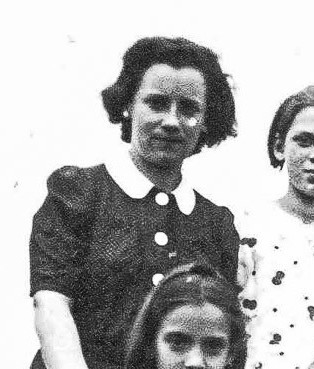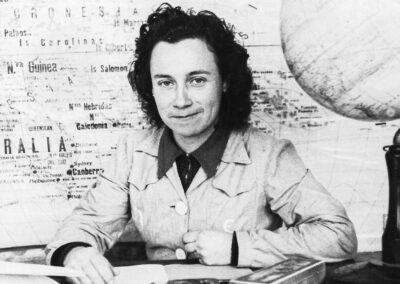BIOGRAPHY
Isabel Etxeberria Gorriti was born in San Sebastián, Basque Country, Spain, on 31 January 1915. Her mother, Lorenza Gorriti Olaizola, was originally from Arroa, while her father, José Antonio Etxeberria Rementeria, came from Deba. He worked as a draughtsman for the Provincial Council of Gipuzkoa and served as an assistant to the architect Ramón Cortázar Urruzola. She had four siblings: two sisters, Benita and María Teresa, and two brothers, Juan and Modesto.
As a child, she attended various schools. She spent two years as a boarder at a Carmelite school in Zumaia before completing her high school education at the Teresian School in San Sebastián. She graduated at the age of 16, coinciding with the proclamation of the Second Republic in 1931. Although she knew she wanted to continue her studies, she was uncertain about her vocation. Inspired by the new curriculum introduced by the Second Republic, she chose to pursue a career in teaching—both for her passion for education and the rigorous training teachers received. The profession also offered a higher salary compared to other options at the time, which further influenced her decision.
Students who aspired to become teachers had to pass a rigorous entrance exam after completing secondary school to secure one of the limited spots at the Teacher Training School. Following three years of intensive study, they faced a final examination before taking the last step: a year of practical training in a school, receiving the same salary as a teacher. Isabel began her studies at the Normal School of San Sebastián in the autumn of 1932, where she studied English, among other subjects. She chose to specialize in science. Isabel successfully completed her first three years of study. Before stepping into a real classroom, she had to pass a revalidation exam, which she did with ease.
Starting in October 1935, Isabel began her teaching internship in Quintanilla de la Ribera, a small town in Álava, at a newly established school. She taught a class of 14 children. Before completing their internship, each teacher underwent a classroom inspection by an official examiner—this served as the final test. Those who passed were assigned a permanent teaching position and received a salary increase. When the inspector visited Isabel’s school, the evaluation went smoothly. However, just around that time, the Spanish Civil war broke out.
On 11 September 1937, she was temporarily transferred to Getaria, a fishing village in Guipúzcoa. Unlike in Quintanilla, her class there consisted solely of boys. Getaria’s proximity to San Sebastián allowed her to visit her family every weekend. On 17 September 1939, she was reassigned to another town, Gabiria, in the south of Guipúzcoa. In Gabiria, she taught a group of girls in a rural school, where she remained until December 1943.
After the Franco government’s 1943 competition for teacher placements, she secured a teaching position on 4 December 1943, in the small fishing town of Llançà, Catalonia. She began teaching there on 1 January 1944. Llançà was a strongly Republican town, with most of its residents being farmers and fishermen. She remained in her post until her retirement on 30 June 1980. Though she was initially set to retire in January, Isabel chose to retire three months earlier to avoid leaving the children halfway through the school year. As a result, she forfeited a three-year term that would have increased her pension slightly.
In Llançà, she met her husband, Miguel Fa Caula, one day while he was dancing the sardana in the Plaça Major. The couple had two daughters, Mayra and Maria Dolors. Miguel was a talented draftsman with a keen artistic sensibility, and he often created drawings to display at her school.
On 12 September 2020, at the age of 105, a public tribute was held in her honor. The event took place in Llançà and was organized by the Llançà and Getaria Town Halls, along with the Aranzadi Science Society, to recognize her work as a teacher who was purged by Francoism and to celebrate her lifelong career.
In 2021, the Generalitat of Catalonia awarded her the Creu de Sant Jordi (Cross of Saint George). The award was presented by Pere Aragonès, President of the Generalitat of Catalonia, at a ceremony held on 13 December 2021, at the Municipal Theater of Barberá del Vallés.
RECOGNITION
Her age has not been validated.
ATTRIBUTION
* Isabel Echeverría Gorriti – Donostia.eus
* “La mestra que estima els nens des de 1915” – LA MIRA, 30 June 2021
* “Isabel Etxeberria, maestra de la República, mantiene sus ideales intactos a los 106 años” – andra.eus, 15 December 2021


